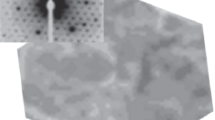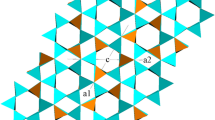Abstract
A vermiculite-aniline intercalate with a basal spacing of 14.78 Å was investigated by one- and two-dimensional X-ray diffraction methods. The intercalate, prepared by ion exchange between Na-saturated vermiculite from Llano, Texas, and a 1% aniline hydrochloride solution, contains only one aniline cation per single layer cell. A reduced effective cell-charge is believed to be responsible for this. Structure factor calculations were made in space group C2/c and with unit cell dimensions of a = 5.33, b = 9.18, c = 29.78 Å, and β = 97.0°. However, extra reflections in the a*b* plane, which are similar to those in a vermiculite-benzidine intercalate, showed that after aniline intercalation the true unit cell became primitive. The aniline cations are distributed statistically over equivalent crystallographic sites in the interlayer space. The organic molecules are orientated with their planes vertical and their nitrogen atoms over the projected centers of the ditrigonal cavities into which they key. The aniline cations form ordered arrays upon the silicate layers by packing into rows. Perpendicular to [010], populated and vacant rows alternate. Along populated rows aromatic ring planes are alternately parallel and perpendicular to [010]. With small adjustments this model is similar to that of benzidine-vermiculite.
Резюме
Прослойка вермикулит-анилин с промежутком 14,78 Å исследовалась при помощи одно- и двухразмерного порошкового рентгеновского анализа. Прослойка, подготовленная при помощи обмена ионов между Na-насыщенным вермикулитом из Ддано, Тексас, и 1% расивором, анилинового хлоргидрата, содержит только один анилиновый катион в ячейке одиночного слоя. Кажется, что уменьшенный эффективный заряд ячейки является ответственным за это. Расчеты структурального фактора были проведены в пространственной группе С2/с при размерах элементарной ячейки a = 5,33, b = 9,18, c = 29,88 Å, и ß = 97,0°. Однако, добавочные отражения в плоскости a* b*, похожие на отражения для прослойки вермикулит-бензидин, указывали на то, что после внедрения анилина истинная ячейка является первозданной. Катионы анилина распределены статистически по эквивалентных кристаллографических местах в межслойной области. Органические молекулы ориентированы вертикально своими плоскостями и атомы азота распределены по центрам дитригональных полостей, в которых они заклиниваются. Катионы анилина образуют упорядоченные ряды над силикатовыми слоями. Перпендикулярно к [010] заполненные и пустые ряды заменяются. Проскости ароматических колец чередуются перпендикулярно и параллельно к [010] вдоль заполненных рядов. С малыми поправками эта модель похожа на модель для прослойки бензидин-вермикулит. [E.G.]
Resümee
Eine Vermiculit-Anilin-Wechsellagerung mit einem Basisabstand von 14,78 Å wurde mittels ein-und zweidimensionalen Röntgendiffraktionsmethoden untersucht. Die Wechsellagerung, die durch Ionenaustausch zwischen Na-gesättigtem Vermiculit von Llano, Texas, und l%iger Anilinhydrochloridlösung hergestellt wurde, enthält nur ein Anilinkation pro einzelner Zellschicht. Eine reduzierte effektive Zeil-Ladung wird dafür verantwortlich gemacht. Berechnungen des Suukturfaktors wurden in der Raumgruppe C2/c und mit einer Elementarzelle von a = 5,33, b = 9,18, C = 29,78 Å, sowie mit einem β von 97,0° durchgeführt. Zusätzliche Reflexe in der a*b* -Ebene, die denen in einer Vermiculit-Benzidin-Wechsellagerung ähneln, zeigen jedoch, daß nach dem Einbau von Anilin die eigentliche Elementarzelle primitiv wird. Die Anilinkationen sind statistisch auf kristallographisch gleichwertigen Plätzen zwischen den Schichten verteilt. Die organischen Moleküle sind so orientiert, daß ihre Ebenen vertikal stehen, und ihre Stickstoffatome über den projezierten Mittelpunkten der ditrigonalen Hohlräume liegen, in die sie hineinreichen. Die Anilinkationen sind strukturell in Reihen auf den Silikatschichten angeordnet. Senkrecht zu [010] wechseln sich besetzte und leere Reihen ab. Entlang den besetzten Reihen sind die aromatischen Ringebenen abwechselnd parallel und senkrecht zu [010] angeordnet. Mit geringen Angleichungen ähnelt dieses Modell dem von Benzidin-Vermiculit. [U.W.]
Résumé
On a investigué un intercalat vermiculite-aniline ayant un espacement de base de 14,78 Å par des méthodes de diffraction de rayons-X à une et deux dimensions. L’intercalat, préparé par un échange d’ions entre une vermiculite saturée de Na provenant de Llano, Texas et une solution d’hydrochloride aniline à 1%, ne contient qu’un cation d’aniline par maille à couche unique. On croit qu’une réduction de l’éfficacité de la charge de maille est responsable pour ceci. Des calculs de facteur structural ont été faits sur le groupe d’espace C2/c, et avec des dimensions de maille mère de a = 5,33, b = 9,18, c = 29,78 Å, et β = 97,0°. Cependant, d’avantage de réflections dans le plan a*b*, qui sont semblables à celles dans un intercalat vermiculite-benzidine, ont montré qu’après intercalation d’aniline, la maille mère réelle devenait primitive. Les cations aniline sont distribués statistiquement sur des sites cristallographiques équivalents dans l’espace intercouche. Les molécules organiques sont orientées de manière que leurs plans sont verticaux et que leurs atomes nitrogènes sont sur les centres projetés des cavités ditrigonales dans lesquelles ils s’insèrent. Les cations d’aniline forment des ordres rangés sur les couches silicates en s’empillant en rangées. Des rangées occupées et vides alternent perpendiculairement à [010]. Le long des rangées occupées, des plans d’encerclement de composes arômatiques sont alternativement parallèles et perpendiculaires à [010]. Avec des petits ajustements, ce modèle est semblable à celui de la benzidine-vermiculite.
Similar content being viewed by others
References
Burnham, C. W. (1963) GNABS, program for computing transmission factors for crystals of essentially arbitrary shape: Geophysical Laboratory, Carnegie Institution, Washington, D.C. (personal communication).
Busing, W. R., Martin, K. O., and Levy, H. A. (1962) ORFLS, a Fortran crystallographic least-squares program: Oak Ridge Natl. Lab. Tech. Mem. 305, Oak Ridge National Laboratory, Tennessee, 75 pp.
Calvet, R. and Prost, R. (1971) Cation migration into empty octahedral sites and surface properties of clays: Clays & Clay Minerals 19, 175–186.
Freeman, H. C., Guss, J. M., Nockolds, C. E., Page, R., and Webster, A. (1970) Operation of a computer-controlled equi-inclination X-ray diffractometer: Acta Crystallogr. A26, 149–152.
Iglesias, J. E. and Steinfink, H. (1974) A structural investigation of a vermiculite-piperdine complex: Clays & Clay Minerals 22, 91–95.
International Tables for X-ray Crystallograph. (1974) Revised and supplementary tables: Kynoch Press, Birmingham, 4, 72–98.
Johns, W. D. and Sen Gupta, P. K. (1967) Vermiculite-al-kylammonium complexes: Amer. Mineral. 52, 1706–1724.
Martin-Rubi, J. A., Rausell-Colom, J. A., and Serratosa, J. M. (1974) Infrared absorption and x-ray diffraction study of butylammonium complexes of phyllosilicates: Clays & Clay Minerals 22, 87–90.
Mathieson, A. McL. (1958) Mg-vermiculite: a refinement and re-examination of the crystal structure of the 14.36 Å phase: Amer. Mineral. 43, 216–227.
Norrish, K. (1973) Factors in the weathering of mica to vermiculite: in Proc. Int. Clay Conf., Madrid, 1972, J. M. Serratosa, ed., Div. Ciencias C.S.I.C., Madrid, 417–432.
Shirozu, H. and Bailey, S. W. (1966) Crystal structure of a two layer Mg-vermiculite: Amer. Mineral. 52, 1124–1143.
Slade, P. G. and Raupach, M. (1982) Structural model for benzidine-vermiculite: Clays & Clay Minerals 30, 297–305.
Author information
Authors and Affiliations
Rights and permissions
About this article
Cite this article
Slade, P.G., Stone, P.A. Structure of a Vermiculite-Aniline Intercalate. Clays Clay Miner. 31, 200–206 (1983). https://doi.org/10.1346/CCMN.1983.0310305
Received:
Accepted:
Published:
Issue Date:
DOI: https://doi.org/10.1346/CCMN.1983.0310305




